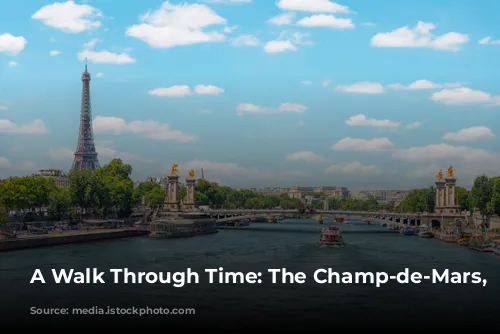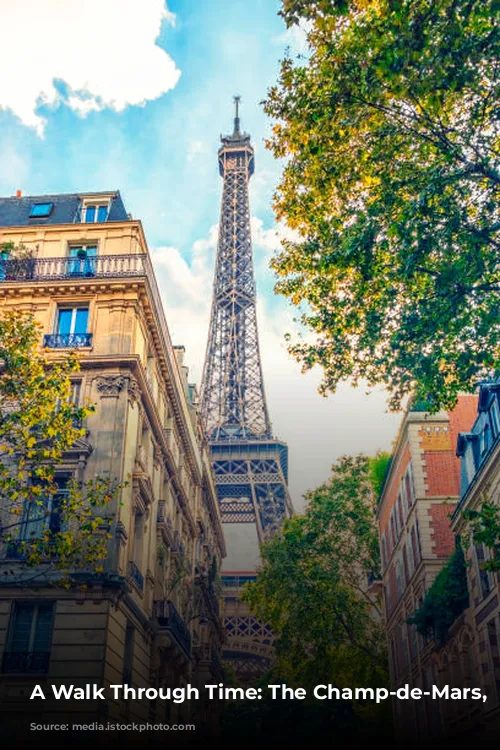The Champ-de-Mars, a spacious public garden located in the heart of Paris, is an iconic green space offering a glimpse into the city’s rich history. It stretches between the majestic Eiffel Tower to the northwest and the École Militaire to the southeast, covering a vast expanse of 24.5 hectares, making it one of the largest green spaces in Paris.

From Roman Origins to Revolutionary Epicenter
The name Champ-de-Mars, meaning “Field of Mars,” is a nod to the Roman god of war, highlighting the park’s historical connection to military maneuvers and parades. This expansive field, situated in the center of Paris, was once a vast space used for military exercises, capable of holding up to 10,000 soldiers in formation, enclosed by imposing wrought iron gates.
Prior to the French Revolution, the Champ-de-Mars was a tranquil patch of countryside, known as the plain of Grenelle, used for market gardening. However, the construction of the École Militaire in 1765 by Gabriel, a prominent architect, transformed its purpose, re-establishing it as a dedicated space for military use. This construction also shaped the landscape of the Champ-de-Mars, with the main facade of the École Militaire forming a defining boundary along its northern edge.
The Champ-de-Mars witnessed momentous events that shaped the course of the French Revolution. The joyous atmosphere of the Feast of the Federation, celebrated on July 14, 1790, marked the first anniversary of the Revolution’s start. This celebration was a historic moment when the French populace felt a unified sense of national identity. The park was filled with over 400,000 Parisians, as well as provincial federates, witnessing the King’s oath to the Constitution and the collective celebration of the nation.
However, the Champ-de-Mars also bore witness to the darker side of the Revolution, marked by the tragic “Soothing of the Champ-de-Mars” on July 17, 1791. A petition signed by thousands demanding the end of the monarchy was met with a violent crackdown by the authorities. The massacre, fueled by the fear of popular unrest, left 50 people dead and many more injured, forever etching the memory of the Revolution’s brutality into the park’s history.

A Tapestry of Festivals and Celebrations
In the years following the Revolution, the Champ-de-Mars continued to be a stage for various events and celebrations, reflecting the changing political landscape. The Cult of Reason, a radical political movement, held its own grand festival, the Feast of the Supreme Being, on June 8, 1794. This event, presided over by Robespierre, aimed to replace the Catholic God with a secular deity representing the ideal of liberty.
The Directoire, a regime that followed the Reign of Terror, also utilized the Champ-de-Mars for its own festivals, including the Festival of Agriculture and the Festival of Old Age, highlighting the changing priorities of the era. The Champ-de-Mars became a canvas for political spectacle, embodying the changing ideals of the French Republic.
The 19th century saw the Champ-de-Mars emerge as a center for grand international exhibitions, showcasing technological advancements and national pride. The World Fairs of 1867, 1878, 1889, 1900, and 1937 were all hosted on the Champ-de-Mars, transforming it into a vibrant hub of innovation and cultural exchange.
The iconic Eiffel Tower, constructed for the 1889 World Fair, stands as a lasting testament to the park’s role in celebrating technological achievements. It was erected on the esplanade of the Champ-de-Mars, a breathtaking symbol of human ingenuity and national progress.

Modern-Day Oasis: A Place to Relax, Reflect, and Celebrate
Today, the Champ-de-Mars is a beloved public park, offering Parisians and visitors alike a sanctuary of green space amidst the bustling city. The park’s broad central lawns are a popular spot for picnicking, relaxing under the sun, or enjoying the views of the Eiffel Tower. It’s also a vibrant space for children, with pony rides, puppet shows, and playgrounds providing endless fun.
The Champ-de-Mars continues to be a venue for grand celebrations, hosting music concerts and firework displays, drawing thousands of people to its open expanse. The park has been the stage for iconic performances by renowned artists like Jean Michel Jarre and Johnny Hallyday, further solidifying its reputation as a place for cultural exchange and entertainment.
As the city of Paris continues to evolve, the Champ-de-Mars remains an enduring symbol of its history, culture, and spirit. It offers a chance to experience the past, present, and future of this vibrant city all in one place, making it an essential stop for any visitor to Paris.










